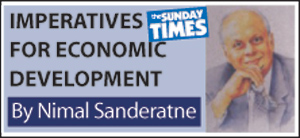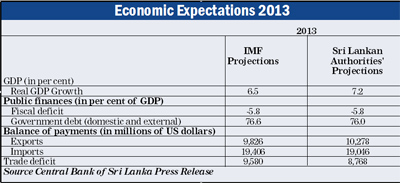Columns
Ending 2013 with signs of economic recovery, expectations and policy concerns
View(s):At year’s end there are signs of an economic recovery. Higher growth in the third quarter and an improved export performance in the second half of the year lend hope of a better economic performance this year than earlier expected. However fundamental weaknesses in public finances, large foreign borrowing, lack of reforms that promote private investment and reduce public inefficiencies and import substitution policies remain serious constraints to economic growth.

Economic growth
The economy is likely to achieve an economic growth of 7.2 per cent this year compared to 6.4 per cent last year. The third quarter economic growth of 7.8 per cent and a likely high growth in the fourth quarter should result in an economic growth of over 7 per cent.
The higher economic growth in the third quarter of 2013 was due to growth in all three sectors: agricultural (7 per cent), industry (8.1 per cent) and services (7.9 per cent). Growth in the last quarter would contribute to economic growth of over 7 per cent this year, higher than the IMF’s earlier estimate of 6.2.
Fiscal outturn
Despite higher economic growth, the expectation of achieving the fiscal deficit target of 5.8 per cent of GDP is not likely to be realised, even though the higher GDP as denominator would assist in lowering the ratio. The fiscal performance in the year disclosed an overrun of expenditure and a poor performance of tax revenues.
However the official estimate of the fiscal deficit may show a figure close to this target, as it does not take into account the government’s growing liabilities to the banking system. An unhealthy financial development has been the proxy borrowing of banks for loss making public enterprises that could jeopardise the financial position of banks or add to government liabilities in the future.
The debt to GDP ratio that increased to 79 per cent of GDP last year is expected to decline to 76 per cent this year. The decrease is despite the increased debt due to the GDP growth. However, foreign and domestic debt continues to be a burden. Last year the debt servicing costs exceeded government revenue. This is likely to be about the same this year too.
Decrease in trade deficit
The improvement in the trade balance discussed last week is certainly a reason for optimism. The trade deficit may turn out to be somewhat less than originally estimated by the Central Bank, if the spurt in exports in September and October continues and import expenditure is restrained. The trade deficit is likely to dip below US$9 billion: less than in the previous two years and what was anticipated earlier.

A continuous improvement in exports either due to the global recovery or the rupee depreciation will ease the balance of payments that is likely to benefit from higher tourist earnings and inflows of workers’ remittances that are continuing to increase by about 12 per cent this year.
Infrastructure improvements
One of the patent achievements of the Government is the improvement in physical infrastructure. Roads, bridges, energy generation, ports and airports have been built. Most of these should contribute to the country’s future economic development, albeit gradually.
There have, however, been serious doubts that some large infrastructure projects may not bring adequate returns even in the long run. Although it would have been prudent for the Government to have made an ex-ante assessment of the costs and benefits of these projects, now that the large investments have been made, the way forward is to find ways and means by which these investments could bear fruit.
Way forward
There are examples around the world where what appeared to be imprudent investments in unproductive huge projects have been made to bear fruit later. There are already plans afoot to develop the Hambantota port into a specialised shipping harbour for particular types of traffic.
Similarly, there is a possibility of using the Mattala airport for a new wave of tourism whose activities begin in the Southern coastline extending to the Eastern beaches and then inwards into the hill country and ancient cities and returning via western coastal areas. Such visions of tourist development together with air cargo traffic from the hinterland are prospects to explore.
Policy concerns
The year saw a further tendency of the Government to espouse import substitution and inward-looking policies. As pointed out last week, these are failed policies both in Sri Lanka and other countries. Even communist countries such as China and Vietnam have veered away from them and liberalised their trade.

The spurt of high economic growth in China and Vietnam are clear evidence of economic strategies based on comparative advantage being successful. India that adopted inward-looking policies for a long period stagnated until it adopted liberalised trade policies and placed greater reliance on private foreign and domestic investment. Consequently these economies achieved unprecedented high economic growth.
One would hope that the rationale for liberalised trade and private enterprise development would be recognised in the coming year and a new thrust in policies would ensue.
Summing up
The year ends on a note of economic recovery and expectations mainly due to an upturn in the global economy, favourable weather conditions, a tourist boom and continuing inflow of workers’ remittances. It is vital for the country to undertake reforms that would enhance the economic efficiency of the public sector and encourage private investment that were lacking in 2013. There were also signs of unhealthy policy reversals. Unless there are policy changes that improve the investment climate, sustaining economic growth would be a serious challenge.
This year will probably be remembered more as one of celebration in holding CHOGM. Much money was spent to give Sri Lanka an image of a country that had revived after nearly three decade of war.
There were expectations of enhanced foreign investment after the Commonwealth Conference. However, this could be realised only if economic policies conducive to foreign investment and the rule of law is implemented.

